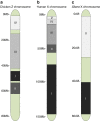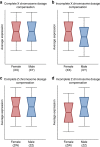How to make a sex chromosome
- PMID: 27373494
- PMCID: PMC4932193
- DOI: 10.1038/ncomms12087
How to make a sex chromosome
Abstract
Sex chromosomes can evolve once recombination is halted between a homologous pair of chromosomes. Owing to detailed studies using key model systems, we have a nuanced understanding and a rich review literature of what happens to sex chromosomes once recombination is arrested. However, three broad questions remain unanswered. First, why do sex chromosomes stop recombining in the first place? Second, how is recombination halted? Finally, why does the spread of recombination suppression, and therefore the rate of sex chromosome divergence, vary so substantially across clades? In this review, we consider each of these three questions in turn to address fundamental questions in the field, summarize our current understanding, and highlight important areas for future work.
Figures


References
-
- Bachtrog D. et al. Are all sex chromosomes created equal? Trends Genet. 27, 350–357 (2011). - PubMed
-
- Beukeboon L. W. & Perrin N. The Evolution of Sex Determination Oxford University Press (2014).
-
- Bergero R. & Charlesworth D. The evolution of restricted recombination in sex chromosomes. Trends Ecol. Evol. 24, 94–102 (2009). - PubMed
Publication types
MeSH terms
Grants and funding
LinkOut - more resources
Full Text Sources
Other Literature Sources

